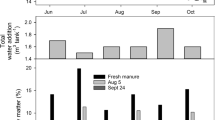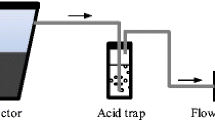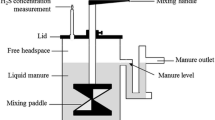Abstract
When manure slurry is removed from storages for land application, there is often ‘aged’ manure that remains because the storages are not completely emptied. Aged manure may act as an inoculum and alter subsequent methane (CH4), nitrous oxide (N2O) and ammonia (NH3) emissions when fresh manure is added to the system, compared to an empty storage that is filled with fresh manure. Completely emptying manure storages may be a practice to decrease gas emissions, however, little pilot-scale research has been conducted to directly quantify the inoculum effect. Therefore, we compared CH4, N2O, and NH3 emissions from three pilot-scale slurry tanks (~10.5 m3 each) filled with a mixture of fresh manure and an inoculum of previously stored manure (i.e., partial emptying) to three tanks that contained only fresh manure (i.e., complete emptying). Gas fluxes were continuously measured over 155 d of warm season storage using flow-through steady-state chambers. The absence of an inoculum significantly reduced CH4 emissions by 56 % compared to partially emptied (inoculated) tanks, while there was no difference in N2O emissions. There was a significant 49 % reduction in greenhouse gas (GHG) emissions because the overall budget (as CO2-eq) was dominated by CH4. Complete manure storage emptying could be an effective GHG mitigation strategy; however, NH3 emissions were significantly higher from un-inoculated tanks due to slower crust formation. Therefore additional NH3 abatement should be considered.


Similar content being viewed by others
Abbreviations
- CO2-eq:
-
Carbon dioxide equivalents
- GHG:
-
Greenhouse gas
- TAN:
-
Total ammoniacal nitrogen
- TN:
-
Total nitrogen
- TS:
-
Total solids
- VS:
-
Volatile solids
References
Bjorneberg DL, Leytem AB, Westerman DT, Griffiths PR, Shao L, Pollard MJ (2009) Measurements of atmospheric ammonia, methane and nitrous oxide at a concentrated dairy production facility in Southern Idaho using open-path FTIR spectrometry. Trans ASABE 52(2):1749–1756
Clesceri LS, Greenberg AE, Eaton AD (1998) Standard methods for the examination of water and wastewater, 20th edn. American Public Health Association, American Water Works Association, Water Environment Federation, Washington
Dong H, Mangino J, MacAllister T, Hatfield JL, Johnson DE, Lassey KR, de Lima MA, Romanovskaya A, Bartman D, Gibb D, Martin JH Jr (2006) Emissions from livestock and manure management. In: Eggleston S, Buendia L, Miwa K, Ngara T, Tanabe K (eds) 2006 IPCC guidelines for national greenhouse gas inventories, prepared by the national greenhouse gas inventories programme, vol 4. IGES, Japan, pp 10.11–10.87
Forster P, Ramaswamy V, Artaxo P, Berntsen T, Betts R, Fahey DW, Haywood J, Lean J, Lowe DC, Myhre G, Nganga J, Prinn R, Raga G, Schulz M, Van Dorland R (2007) Changes in atmospheric constituents and in radiative forcing. In: Solomon S, Qin D, Manning M et al (eds) Climate change 2007: the physical science basis. contribution of working group I to the fourth assessment report of the intergovernmental panel on climate change. Cambridge University Press, Cambridge
Harper LA, Sharpe RR, Parkin TB (2000) Gaseous nitrogen emissions from anaerobic swine lagoons: ammonia, nitrous oxide, and dinitrogen gas. J Environ Qual 29(4):1356–1365
Kottek M, Grieser J, Beck C, Rudolf B, Rubel F (2006) World map of the Köppen–Geiger classification updated. Meteorol Z 15(3):259–263
Leytem AB, Dungan RS, Bjorneberg DL, Koehn AC (2011) Emissions of ammonia, methane, carbon dioxide, and nitrous oxide from dairy cattle housing and manure management systems. J Environ Qual 40(5):1383–1394. doi:10.2134/jeq2009.0515
Leytem AB, Dungan RS, Bjorneberg DL, Koehn AC (2013) Greenhouse gas and ammonia emissions from an open-freestall dairy in Southern Idaho. J Environ Qual 42(1):10–20. doi:10.2134/jeq2012.0106
Livingston GP, Hutchinson GL (1995) Enclosure-based measurement of trace gas exchange: applications and sources of error. In: Matson P, Harriss R (eds) Biogenic trace gases: measuring emissions from soil and water. Blackwell Science Ltd., Oxford, pp 14–51
Massé DI, Masse L, Claveau S, Benchaar C, Thomas O (2008) Methane emissions from manure storages. Trans ASABE 51(5):1775–1781
McGinn S, Beauchemin KA (2012) Dairy farm emissions using a dispersion model. J Environ Qual 41:73–79
Misselbrook TH, Brookman SKE, Smith KA, Cumby T, Williams AG, McCrory DF (2005) Crusting of stored dairy slurry to abate ammonia emissions: pilot-scale studies. J Environ Qual 34(2):411–419
Olesen JE, Sommer SG (1993) Modelling effects of wind speed and surface cover on ammonia volatilization from stored pig slurry. Atmos Environ 27A(16):2567–2574
Park K-H, Thompson AG, Marinier M, Clark K, Wagner-Riddle C (2006) Greenhouse gas emissions from stored liquid swine manure in a cold climate. Atmos Environ 40(4):618–627
Petersen SO, Miller D (2006) Greenhouse gas mitigation by covers on livestock slurry tanks and lagoons? J Sci Food Agric 86:1407–1411
Petersen SO, Amon B, Gattinger A (2005) Methane oxidation in slurry storage surface crusts. J Environ Qual 34(2):455–461
Petersen SO, Anderson AJ, Eriksen J (2012) Effects of cattle slurry acidification on ammonia and methane evolution during storage. J Environ Qual 41:88–94
Rochette P, Hutchinson GL (2005) Measurement of soil respiration in situ: chamber techniques. In: Hatfield J, Baker JM, Viney M (eds) Micrometeorology in agricultural systems. ASA-CSSA-SSSA Publishers Inc., Madison, pp 247–286
Rodhe LKK, Abubaker J, Ascue J, Pell M, Nordberg A (2012) Greenhouse gas emissions from pig slurry during storage and after field application in northern European conditions. Biores Technol 113:379–394
Shah SB, Kolar P (2012) Evaluation of additive for reducing gaseous emissions from swine waste. Agric Eng Int: CIGR J 14(2):10–20
Sheppard S, Bittman S, Swift M, Beaulieu M, Sheppard M (2011) Ecoregion and farm size differences in dairy feed and manure nitrogen management: a survey. Can J Anim Sci 91(3):459–473
Sommer SG, Christensen BT, Nielsen NE, Schjorring JK (1993) Ammonia volatilization during storage of cattle and pig slurry—effect of surface cover. J Agric Sci 121:63–71
Sommer SG, Petersen SO, Sogaard HT (2000) Greenhouse gas emissions from stored livestock slurry. J Environ Qual 29(3):744–751
Sommer SG, Petersen SO, Sorensen P, Poulsen HD, Moller HB (2007) Methane and carbon dioxide emissions and nitrogen turnover during liquid manure storage. Nutr Cycling Agroecosyst 78(1):27–36
Steed J, Hashimoto A (1994) Methane emissions from typical manure management systems. Biores Technol 50:123–130
VanderZaag AC, Gordon RJ, Glass VM, Jamieson RC (2008) Floating covers to reduce gas emissions from liquid manure storages: a review. Appl Eng Agric 24(5):657–671
VanderZaag AC, Gordon RJ, Jamieson RC, Burton DL, Stratton GW (2009) Gas emissions from straw covered liquid dairy manure during summer storage and autumn agitation. Trans ASABE 52(2):599–608
VanderZaag AC, Gordon RJ, Jamieson RC, Burton DL, Stratton GW (2010a) Effects of winter storage conditions and subsequent agitation on gaseous emissions from liquid dairy manure. Can J Soil Sci 90:229–239
VanderZaag AC, Gordon RJ, Jamieson RC, Burton DL, Stratton GW (2010b) Permeable synthetic covers for controlling emissions from liquid dairy manure. Appl Eng Agric 26(2):287–297
Wood JD, Gordon RJ, Wagner-Riddle C, Dunfield KE, Madani A (2012) Relationships between dairy slurry total solids, gas emissions, and surface crusts. J Environ Qual 41(3):694–704. doi:10.2134/jeq2011.0333
Acknowledgments
We wish to acknowledge the technical support provided by Donna MacLennan, John McCabe, Paul MacNeil, Devon Pires, and the staff of the Dalhousie University Agriculture Faculty Experimental Farm. The funding support provided by the Natural Sciences and Engineering Research Council (NSERC), the Dairy Farmers of Canada, the Ontario Agricultural College, the Ontario Ministry of Agriculture and Food, and Agriculture and Agri-Food Canada under the Agricultural Greenhouse Gases Program is gratefully acknowledged.
Author information
Authors and Affiliations
Corresponding author
Electronic supplementary material
Below is the link to the electronic supplementary material.
Rights and permissions
About this article
Cite this article
Wood, J.D., VanderZaag, A.C., Wagner-Riddle, C. et al. Gas emissions from liquid dairy manure: complete versus partial storage emptying. Nutr Cycl Agroecosyst 99, 95–105 (2014). https://doi.org/10.1007/s10705-014-9620-2
Received:
Accepted:
Published:
Issue Date:
DOI: https://doi.org/10.1007/s10705-014-9620-2




